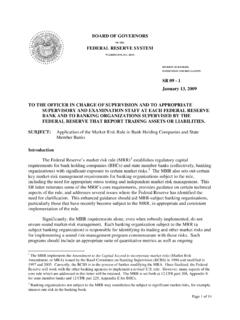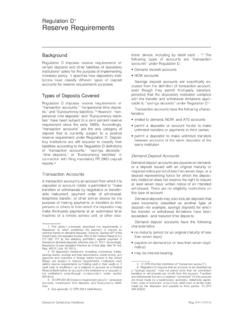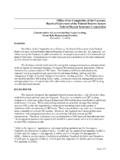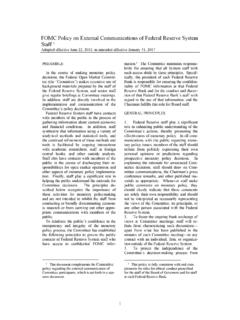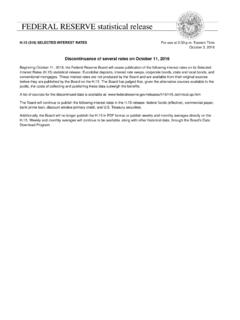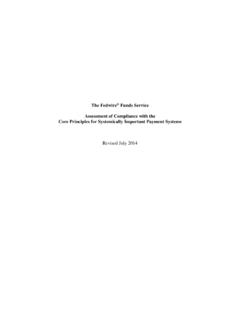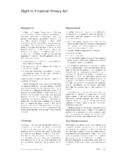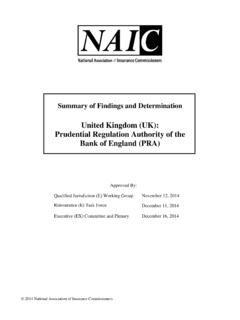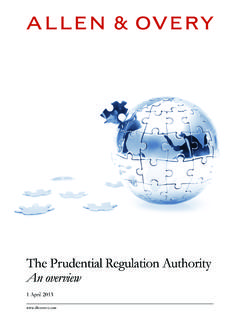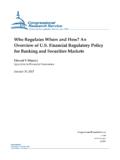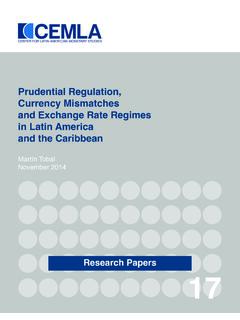Transcription of Rethinking the Aims of Prudential Regulation - The Fed
1 For release on delivery 8:30 CDT/9:30 EDT May 8, 2014 Rethinking the aims of Prudential Regulation Remarks by Daniel K. Tarullo Member Board of Governors of the federal reserve system at the federal reserve Bank of Chicago Bank Structure Conference Chicago May 8, 2014 Among the questions posed by the organizers of this 50th Annual Conference on Bank Structure and Competition is how the regulatory-supervisory framework has fundamentally changed. I think one answer is that the aims and scope of Prudential Regulation have been fundamentally redefined since the financial crisis. Most significantly, a concern with financial stability and an increased emphasis on macroprudential Regulation have informed major changes in both banking law and supervision.
2 This salutary shift in perspective has important implications for Prudential Regulation . One is that Prudential Regulation must deal with threats to financial stability whether or not those threats emanate from traditional banking organizations. Hence the need to broaden the perimeter of Prudential Regulation , both to certain nonbank financial institutions and to certain activities by all financial actors. A second implication to which I will devote most of my remarks this morning is that the aims of Prudential Regulation for traditional banking organizations should vary according to the size, scope, and range of activities of the organizations.
3 By specifying these aims with more precision, we can shape both a more effective regulatory system and a more efficient one. That is, once we have specified the regulatory aims for a particular type of financial institution, we can more effectively rationalize and, as appropriate, differentiate the rules and requirements to be applied to each kind of institution. The Legacy of a Unitary Approach to Bank Regulation When I was teaching banking law prior to my appointment to the Board of Governors, I noticed an interesting disconnect in the best casebooks in the field. An introductory chapter on the history and purposes of bank Regulation revealed a complicated set of issues concerning changes in the structure and activities of banks, which, among other things, suggested that the rationales for regulating banks might vary depending on the size, business model, and affiliations - 2 - of a bank.
4 Yet the remaining chapters of the casebooks treated bank Regulation as a more or less unitary endeavor with Prudential rules applicable in about the same way to the activities and affiliations of all banking organizations, and only to banking organizations. To be sure, topics such as bank affiliations with nonbank financial institutions were, for practical reasons, more focused on larger banks. And there were a few measures directed at the more complicated balance sheets of larger banks, such as the Basel II internal ratings-based (IRB) approach to regulatory capital, although there was no evidence the underlying purpose of capital Regulation differed.
5 But in all the chapters elaborating applicable doctrine and rules, there was little hint that the purposes and principles of bank Regulation might vary across the bank population. And, to the extent that nonbank financial institutions such as broker-dealers, investment companies, or insurance companies were covered, the pedagogical point seemed to be that the aims of regulating these kinds of firms were dominantly investor and customer protection not Prudential considerations such as limiting moral hazard, much less fostering financial stability. The reason for this disconnect was, to a great extent, that pre-crisis statutes and regulations reflected what I have termed a unitary approach to banking Regulation .
6 The core of banking Regulation could be explained with a relatively simple narrative, by which deposit insurance and access to the discount window had been granted to depository institutions in order to forestall runs and panics. The resulting moral hazard and the use of insured deposits as a funding source for these institutions justified everything from capital requirements to limitations on banks getting into nonbanking businesses. Even when traditional banks were permitted to affiliate with other kinds of financial firms, laws such as the Bank Holding Company Act1 and 1 Bank Holding Company Act of 1956, as amended, 12 1841-1850.
7 - 3 - section 23A of the federal reserve Act2 were oriented mostly toward protecting the insured depository institution and the federal deposit insurance fund (DIF) from possible depredation by those nonbank businesses. The activities of broker-dealers, for example, were relevant to Prudential Regulation only insofar as they affected an affiliated depository institution. Of course, banking law had not only tried to protect the DIF from the risky activities of banks and their affiliates. It had also, albeit far less explicitly, tried to protect banks from nonbank competition and, to some degree, from each Just as banks were supposed to stick to their knitting the business of banking so everyone else was supposed to stay out of that business.
8 But as we all know, the distinction between demand for commercial bank loans and for investment bank underwriting of public debt issuance was never absolute, and in the 1970s it began to erode more rapidly with the growth of capital markets and financial innovations such as money market funds. The financial crisis has confirmed that the pre-crisis regulatory structure reflected a view of the financial system that was at once too broad and too narrow. It was too broad in that Prudential rules generally applied to all banks and bank holding companies through a microprudential approach focused on the soundness of each individual bank. The rules were implemented somewhat differently, based on the size and relative complexity of banking organizations, and separate supervisory portfolios were created.
9 But the principles informing Regulation were basically the same whether the institution was a community bank or a holding company with a $1 trillion balance sheet whose failure might shake the entire financial system . 2 12 371c. Section 23A limits transactions between insured depository institutions and their corporate affiliates. 3 For example, restrictions on branching across state lines and, in some cases, within states limited competition significantly until they were loosened through statutory changes, such as the Riegle-Neal Interstate Banking & Branching Efficiency Act, 103-328 (1994).
10 - 4 - The Prudential regulatory structure was too narrow in that it did not extend to firms and activities outside of banking organizations, even those that could pose a threat to financial stability, because the soundness of the federal deposit insurance system was not implicated. Thus Lehman Brothers, whose failure did seriously shake the financial system , was not subject to even the microprudential standards applicable to bank holding companies. The run on the repo market involved a wide range of market actors of different sizes, operating under different regulatory constraints. Redefining Prudential Regulation It is important to recognize that the statutory and administrative changes in Regulation following the financial crisis were not only about strengthening existing Regulation following 30 years of largely deregulatory measures that had preceded the crisis.
